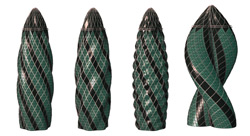Get started with Wolfram technologies, or work with us to apply computational expertise to your projects.
Questions? Comments? Get in touch: 1-800-WOLFRAM, or email us

Computers are already widely used to aid the designer in rendering what he sees in his mind, but how about using the computer to actually generate forms (drawings) for the designer to select from and modify? This was the idea behind the language Grammatica, designed by Chris Carlson and implemented with the aid of Mathematica during his doctoral studies in architecture at Carnegie Mellon University."Grammatica implements a paradigm of exploratory design by incorporating a language for describing styles and standards of design and functioning as a system that can generate examples of a given style," explains Carlson. "In the back end of the system, Mathematica solves the nonlinear constraints that arise in the descriptions of designs, and in the front end, Mathematica renders the results."
For example, Grammatica could help an architect by generating window designs typical of a particular era. Carlson actually tested this by describing (as a 100-statement grammatical program) the forms found in early Gothic window traceries--arches, circles, and cusps--and the relationships they assume in historical examples. Then given the geometry of the outermost arch of a tracery in the Cathedral of St. Étienne, Meaux/Seine-et-Marne, France, Grammatica generated plausible designs for the window.
In addition to describing a historical style, Grammatica could generate alternative floorplans or design brickwork, signage systems, or house frames based on constraints and rules specified by the user. "With these capabilities, Grammatica brings the computer a step closer to being a more substantive partner in the design process," says Carlson.